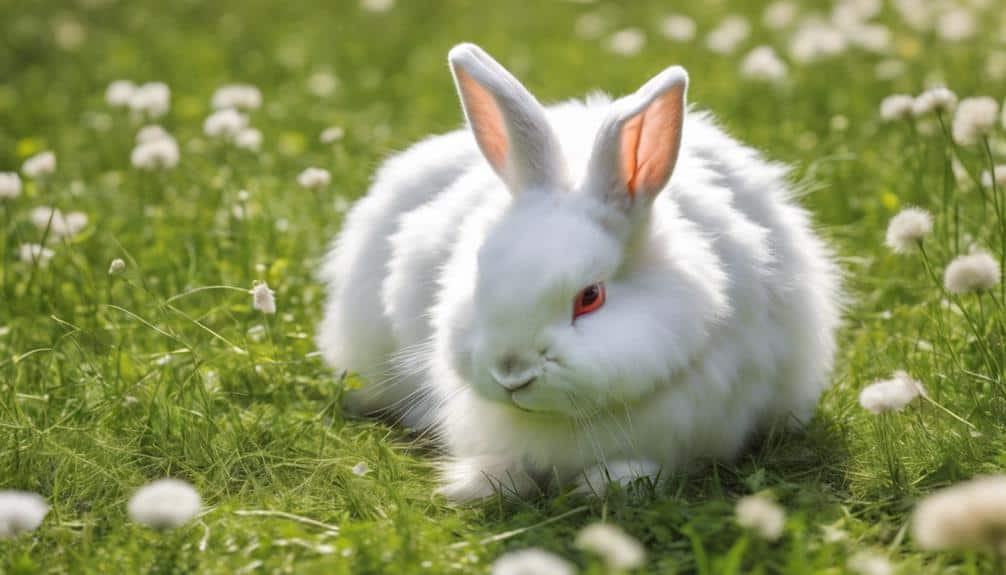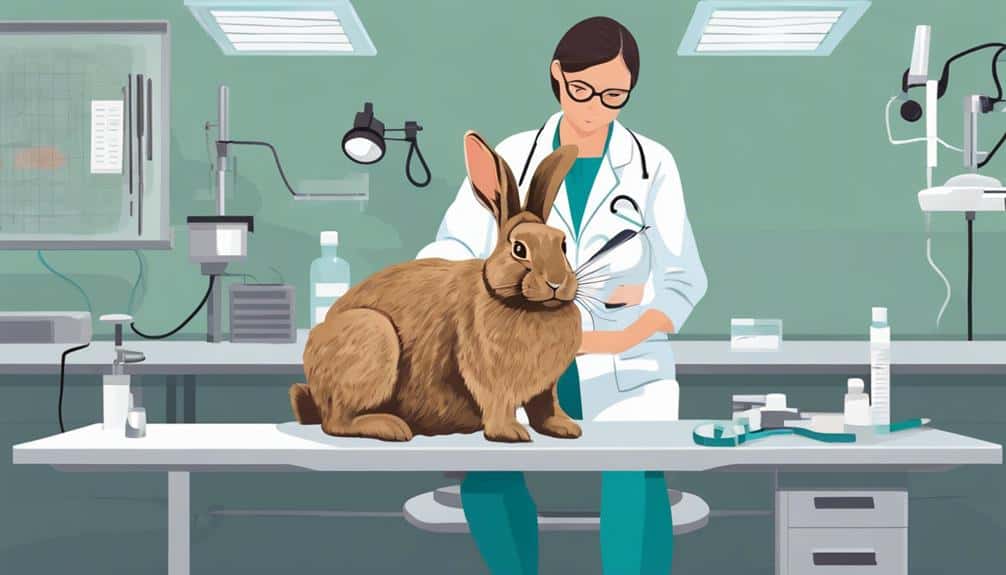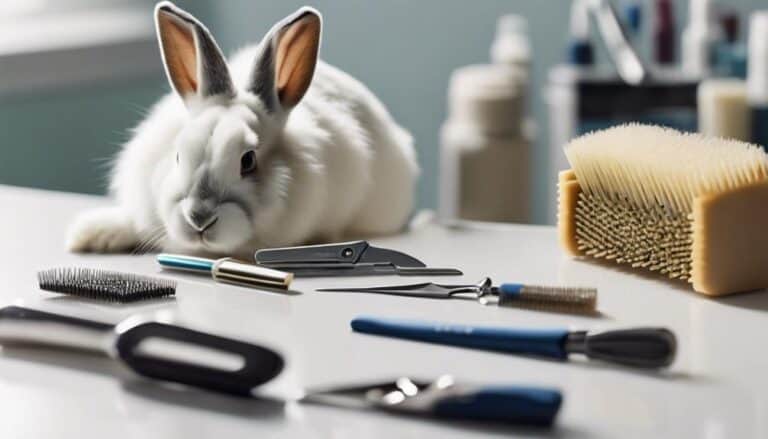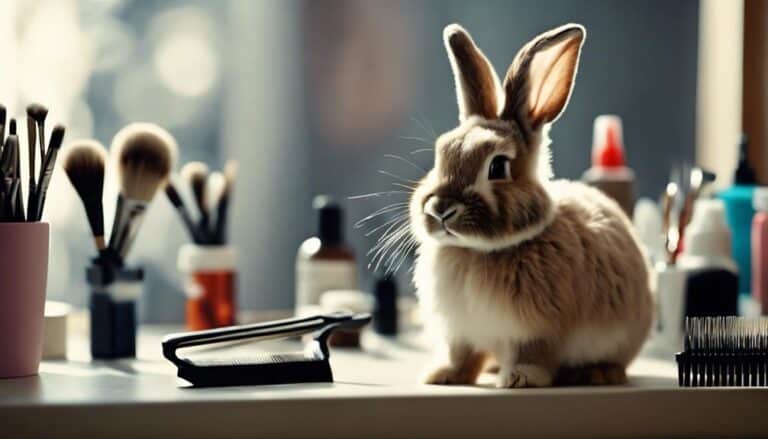You might think rabbits have a secret spa appointment the way they meticulously attend to their grooming needs, but are they truly self-sufficient in this regard?
As you ponder the intricacies of rabbit hygiene, consider the nuances that make these creatures fascinating in their self-care routines.
From delicate paw inspections to meticulous face cleanings, the world of rabbit grooming holds surprises that may challenge your assumptions.
Contents
- 1 Key Takeaways
- 2 Importance of Self-Grooming in Rabbits
- 3 Factors Affecting Rabbits' Grooming Behavior
- 4 Signs of Healthy Self-Grooming in Bunnies
- 5 Common Grooming Challenges for Pet Rabbits
- 6 Safe Handling Techniques During Grooming
- 7 Recommended Grooming Tools for Bunnies
- 8 Preventing Skin Issues Through Proper Grooming
- 9 Seeking Veterinary Care for Grooming Concerns
- 10 Frequently Asked Questions
- 11 What Are the Best Ways to Encourage and Support a Rabbit’s Natural Self-Grooming Habits?
- 12 Conclusion
Key Takeaways
- Rabbits are naturally self-grooming animals for maintaining health and hygiene.
- Balanced diet influences grooming habits, emphasizing the importance of nutrition.
- Stress impacts grooming behavior, affecting overall well-being and skin health.
- Social bonding through grooming indicates trust, hierarchy, and emotional well-being in rabbits.
Importance of Self-Grooming in Rabbits

Why is self-grooming important for rabbits' health and well-being?
Self-grooming plays a crucial role in maintaining the overall health and hygiene of rabbits. These small animals are meticulous groomers, dedicating a significant amount of time to cleaning their fur. Through self-grooming, rabbits make sure that their coat remains clean, soft, and free of tangles. This behavior helps prevent fur ingestion, matting, and skin issues, promoting a healthy skin and coat.
Regular self-grooming also enables rabbits to regulate their body temperature effectively. By removing loose fur and distributing natural oils through grooming, rabbits can keep themselves warm in colder temperatures and cool in warmer climates. Additionally, self-grooming allows rabbits to stimulate blood circulation and exfoliate dead skin cells, contributing to their overall well-being.
In essence, self-grooming is an instinctual behavior in rabbits that goes beyond just appearance. It's a fundamental aspect of their health, making sure that they stay clean, comfortable, and happy.
Factors Affecting Rabbits' Grooming Behavior
When it comes to rabbits' grooming behavior, factors like diet play a vital role.
Your rabbit's grooming habits can be affected by stress levels as well.
Additionally, social interactions and bonding can greatly impact how often and effectively your rabbit grooms itself.
Diet and Grooming
Influenced by their diet composition, rabbits' grooming behavior is intricately linked to their overall health and well-being.
- High-Fiber Diet: Essential for digestive health, it promotes regular gut motility, impacting grooming habits.
- Hay: Critical for dental wear and gastrointestinal health, influencing grooming routines.
- Fresh Vegetables and Limited Pellets: Support a balanced rabbit diet, ensuring proper nutrition and hydration for grooming behavior.
- Water Consumption: Adequate hydration is essential for healthy skin and fur, affecting self-cleaning abilities.
Rabbits thrive when provided with a balanced diet rich in dietary fiber, hay, fresh vegetables, and water. These factors play a critical role in maintaining their overall health, which in turn reflects in their grooming habits and well-being.
Stress and Grooming
Stress greatly impacts rabbits' grooming behavior, potentially leading to excessive over-grooming, resulting in bald patches and skin issues. Changes in their environment, routine, or social interactions can trigger this behavior.
Factors like boredom, loneliness, and fear are common stressors affecting rabbits' grooming habits. To alleviate stress-related grooming problems, providing enrichment, companionship, and a safe, stimulating environment is important.
By monitoring and promptly addressing stressors, you can prevent over-grooming and promote your rabbit's overall well-being. Remember, a happy and stress-free environment plays an important role in maintaining your rabbit's grooming habits and skin health.
Keep a close eye on your rabbit's behavior and environment to important their grooming routine remains healthy and balanced.
Social Bonding Effects
Rabbits exhibit social bonding effects through their grooming behavior, which plays a pivotal role in reinforcing relationships within their groups or pairs.
- Mutual grooming: Rabbits groom each other to strengthen social bonds.
- Establish hierarchy: Grooming helps establish hierarchy and maintain group cohesion.
- Reduce stress: Mutual grooming can reduce stress and anxiety in rabbits.
- Trust and comfort: Grooming behavior can indicate the level of trust and comfort within a rabbit relationship.
Understanding these aspects of social bonding through grooming is pivotal for rabbit owners to guarantee the well-being of their pets.
Lack of grooming between bonded rabbits may signal underlying issues that need addressing promptly. Observing and encouraging grooming behavior can foster trust, comfort, and self-comforting behavior within rabbit groups or pairs.
Signs of Healthy Self-Grooming in Bunnies
Regularly grooming themselves throughout the day, rabbits exhibit clear signs of maintaining good hygiene and overall well-being. Self-grooming is a fundamental behavior in rabbits that goes beyond mere cleanliness.
When a rabbit engages in self-grooming, it meticulously cleans its face, ears, sides, behind, and paws, ensuring every part of its body remains tidy. This behavior not only keeps the rabbit's coat clean, soft, and free of debris but also acts as a form of relaxation and self-care.
Healthy rabbits groom themselves multiple times a day, and this routine grooming is a positive indicator of their mental and physical health.
Common Grooming Challenges for Pet Rabbits

As a rabbit owner, you must be aware of the common grooming challenges that pet rabbits face. Preventing fur matting is essential as it can lead to hairball risks, particularly in long-haired breeds.
Overgrown nails, dirty bottoms, and lack of mental stimulation can also pose significant grooming challenges for your pet rabbit.
Fur Matting Prevention
To prevent fur matting in pet rabbits, consistent grooming practices are essential for maintaining their skin health and overall well-being. Here are some key tips to help you prevent fur matting in your rabbits:
- Daily Grooming: Long-haired rabbits need daily grooming to prevent tangles and mats.
- Mat Splitters: Use mat splitters to gently remove mats without causing discomfort to your rabbit.
- Gentle Brushing Techniques: Employ gentle brushing techniques to keep your rabbit's fur free from tangles and mats.
- Insulation Maintenance: Prevent fur matting to make certain your rabbit's fur can provide adequate insulation and protection against the elements.
Hairball Risks
Hairball risks pose a significant grooming challenge for pet rabbits due to their inability to vomit, making excessive grooming behaviors a significant health hazard.
When rabbits groom themselves, they ingest fur that can accumulate in their digestive tract, forming hairballs. These hairballs can lead to blockages, causing severe health complications for your furry friend.
It's important to monitor your rabbit's grooming behaviors closely to prevent excessive fur ingestion. Providing appropriate grooming tools, such as brushes and combs, can help minimize the risk of hairball formation.
If you notice any signs of distress, decreased appetite, or unusual behavior, seek prompt veterinary care as untreated hairballs can be fatal for rabbits. Regular monitoring of grooming habits is essential for maintaining your rabbit's well-being.
Safe Handling Techniques During Grooming
During rabbit grooming, it's crucial to maintain a secure hold on the rabbit to prevent escape or injury. To guarantee a safe grooming experience, follow these important tips:
- Secure Hold: Always keep a firm grip on the rabbit to prevent sudden movements that could lead to escape or injury.
- Non-Slip Surface: Utilize a non-slip surface during grooming to provide stability and prevent the rabbit from slipping, reducing the risk of injury.
- Avoid Wetting the Head: Unless specifically advised by a vet, avoid wetting the rabbit's head during grooming to prevent stress and discomfort.
- Empty Water Frequently: Regularly empty water during grooming to prevent the rabbit from sitting in dirty water, reducing the risk of chilling and maintaining hygiene.
Recommended Grooming Tools for Bunnies

When grooming bunnies, soft-bristle brushes are recommended tools to guarantee skin irritation. Make grooming your rabbit frequently a priority to maintain their well-being.
Combs, mat rakes, and rubber mitts are useful for tending to your rabbit's coat, guaranteeing it stays clean and free of tangles. Remember to use a soft cloth when cleaning around your rabbit's eyes and ears to guarantee discomfort. Additionally, pay attention to their scent glands and fur during grooming sessions to keep them healthy and happy.
Regular nail trimming is also essential to guarantee overgrowth and potential health issues. While grooming your rabbit, they might try to wriggle away, so it's important to be gentle yet firm. By using the right tools and techniques, you can guarantee that your bunny's grooming routine is effective and stress-free.
Preventing Skin Issues Through Proper Grooming
To maintain your rabbit's skin health and prevent potential issues, proper grooming practices are essential. Here are some key tips to help you keep your rabbit's skin in good condition:
- Groom your rabbit frequently: Regular grooming helps prevent fur matting, which can lead to skin irritations, infections, and reduced protection against external parasites.
- Trim Rabbit Nails: Overgrown nails can cause discomfort and even injury to your rabbit. Regular nail trims are vital to guarantee health problems are avoided and your rabbit can move comfortably.
- Help your rabbit keep themselves clean: While rabbits are excellent self-groomers, assisting them in hard-to-reach areas like their back can prevent matting and skin issues.
- Bond with your rabbit: Grooming sessions aren't only about physical care but also about building a bond with your pet. Spending time grooming your rabbit can reduce stress and anxiety for both of you, promoting overall well-being.
Seeking Veterinary Care for Grooming Concerns

Veterinary care plays a crucial role in addressing grooming concerns for rabbits, guaranteeing their overall health and well-being are maintained. When seeking professional guidance for grooming issues, a vet may recommend specific treatments or grooming techniques tailored to the individual rabbit.
Vets can identify underlying health issues that may impact a rabbit's grooming habits, such as dental problems or arthritis, which can affect their ability to groom properly. Regular vet check-ups are essential for maintaining peak grooming and overall health in rabbits.
These visits allow for early detection of any potential issues and provide an opportunity for the vet to offer advice on how to improve your rabbit's grooming routine. By partnering with a knowledgeable veterinarian, you can make certain that your rabbit receives the necessary care and attention to support their grooming needs and overall well-being.
Frequently Asked Questions
Do Rabbits Groom Themselves?
Yes, rabbits groom themselves regularly to maintain cleanliness and fur health. Grooming behaviors include cleaning face, ears, paws, and more. This grooming routine helps regulate body temperature, remove debris, and keep rabbits content and well-adjusted.
Do Rabbits Clean Themselves When Stressed?
When stressed, rabbits may engage in stress grooming as a self-soothing behavior. This excessive licking serves as an anxiety relief, comfort cleaning, and emotional grooming. It's a stress-induced, relaxation response and coping mechanism for them.
Do Rabbits Groom When They Are Happy?
When you observe your rabbit grooming, it's like a gentle breeze through a field of flowers. Grooming behavior is a natural instinct, a bonding activity, and a health benefit that reflects their contentment and social interactions.
Why Does My Rabbit Lick Himself When I Stroke Him?
When you stroke your rabbit, its self-licking is a comforting gesture showing trust and relaxation. This bonding behavior is a natural instinct for rabbits, providing health benefits, stress relief, and communication signals. It's a social interaction and a sign of mutual grooming.
What Are the Best Ways to Encourage and Support a Rabbit’s Natural Self-Grooming Habits?
To encourage and support a rabbit’s natural self-grooming habits, provide a clean environment and a balanced diet. Use gentle rabbit grooming shampoos sparingly to maintain a healthy coat and avoid over-bathing, which can disrupt their grooming routine. Regularly spot-clean soiled areas to aid in maintaining their cleanliness.
Conclusion
To sum up, rabbits are indeed naturally self-grooming animals, showcasing their meticulous hygiene habits. Regular grooming is crucial for maintaining their health and well-being, ensuring their coat remains soft and clean.
Remember, proper grooming not only keeps your bunny looking sharp but also strengthens the bond between you and your furry friend. So, don't underestimate the power of a well-groomed rabbit – it's like a spa day for them!






